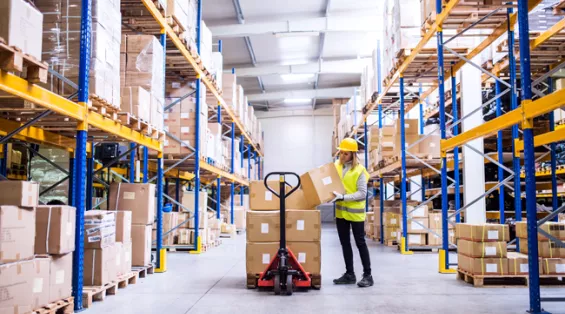Practical Steps For Social Distancing In Warehouses And Distribution Centers
Published on 24 August 2020

The coronavirus has wrought enormous change in six short months since the first case of Covid-19 was diagnosed in Washington state at the end of January.
In that time, many companies have discovered the ability to keep going thanks to remote work. The idea of working from home was just that – an idea – for most companies before the pandemic struck. A number of technology companies have operated on that basis for several years; most of their employees, especially on the sales and marketing side, have home offices and stay in contact with colleagues and the “home office” via technologies like Zoom, Skype, Google Meet, Microsoft Teams, etc.
What the pandemic has done is force many other companies to follow suit – usually with excellent results. These companies may have been toying with the idea of having some employees work from home as a kind of trial run; the pandemic has brought that from the back burner to the front burner and the transition for most employees has been not only smooth but welcomed. As a result, remote work is likely here to stay – even after the pandemic is finally brought under control.
Remote Work Is Not A Blanket Solution
However, there are many companies for whom remote work is not entirely possible; for them, re-opening is fraught with worry and concern over how to keep their workforce safe and healthy. Companies that operate warehouses, distribution centers, transportation, and logistics businesses, need workers on-site.
The challenge is having those employees on site but able to socially distance at the same time. This is not always possible, which is leading some firms to look at robotics and automation to help. For example, Honeywell introduced an automated truck unloading robot last year. The company says the robot can unload a trailer faster than a human using machine learning and what the company calls “machine vision” which allows the robot to see packages and extract them easily and quickly based on size and shape. The artificial intelligence component determines the best approach to unloading.
Matt Wicks, Honeywell’s V.P. of Product Development, says the robot “allows workers to remove themselves from the extreme environment and oversee multiple unloading machines, increasing productivity and improving safety.”
Be Careful When Automating
While this does allow for more social distancing (fewer unloaders in a trailer at any given time), it could also mean having to find other types of work for those no longer needed at the loading docks. Wicks points out that unloading is an onerous task that is “arduous, labor-intensive and injury-prone”. He cites figures from the Bureau of Labor Statistics that show a 36% turnover rate in such work, which makes the Honeywell truck unloader a viable proposition for a company.
Robotics, however, is not a quick fix; it takes time and careful planning to ensure that the equipment is integrated into overall operations smoothly and the capital expense is going to have a positive ROI. So, this is not an overnight solution for most companies.
There is also the simple fact that the pandemic has created havoc with revenue sources. Both supply and demand plummeted when governments ordered businesses to shut down, making the idea of purchasing state of the art technology solutions a moot point for many companies. They’re forced to figure out other solutions that will keep on-site staff safe and virus-free while shepherding limited cash resources.
To make matters even more problematic, there are growing concerns over companies’ liability, should one or more of their employees contract the virus on site. Is it a workers’ compensation issue or a civil matter that triggers a lawsuit? There are no clear answers to this yet but it merely underscores the critical need to take the right steps and not cut corners on workplace safety.
Technology Solutions Like WMS Hold The Key
Throughout the pandemic, there are dozens of examples of how technology has been of great benefit, whether it’s allowing employees to work from home, consumers to order groceries online for delivery or curbside pickup or, in the case of warehouse operators, allowing them to schedule everything from shifts to shipments in ways that maximize efficiency and minimize risk. This is where the value of the warehouse management system (WMS) can shine.
A WMS allows warehouse operators to organize, store, select, and ship goods and materials as and when needed with an efficiency that can only be achieved through cloud-based, AI-driven software.
That same software can allow warehouses and distribution centers (DC) to determine that work with the highest priority will be done first and that the number of tasks can be controlled and organized based on available employee resources. In other words, a WMS can make it possible to limit the number of workers in any area at any time, a critical component for social distancing to succeed.
This leads directly to solutions that Supply and Demand Chain Executive points to on their website, namely:
- Zoning, to control the number of employees in any area of a warehouse or DC at any one time.
- Tasking, defined by Supply and Demand Chain Executive as “… work to be segregated by task type, which reduces the volume and resource allocation required in each area of the warehouse at any given time”.
- User permissions, which can be modified on an ad hoc basis to control the number and spacing of workers who might be order pickers, packers, or receivers.
There may be other solutions that warehouse and DC operators will have to add to their WMS, such as the means to track employee movements during shifts. A number of tech companies have developed Bluetooth-based phone apps that can record an employee’s travels during his or her shift. If that employee were to become infected, the app can determine where the employee went and who he or she might have come into contact with. Known as ‘contact tracing’, this has become a valuable weapon in containing the continued spread of the virus.
Making A Tough Job Easier
There is no question that companies are facing perhaps the most difficult time they’ve ever experienced; running a firm and being in business is tough enough without having to do so during a pandemic. Thanks to WMS technology, a tough job is made a little easier and far more efficient. Generix Group North America offers a complete solution that touches on all the logistical elements in a modern supply chain including warehouse management systems, transportation management systems, enterprise asset management, yard management, order management, and other areas vital to a smooth and efficient supply chain operation.
We invite you to contact us to learn more about how we can help secure your organization’s future in a post-pandemic world.



